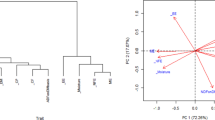Summary
Variations in feeding value characteristics were studied on a factorial mating design, within a multilocal network. The in vitro digestibility of dry matter (IVDDM), neutral detergent fiber (NDF), acid detergent fiber (ADF), acid detergent lignin (ADL), starch, soluble carbohydrate, protein and ash contents were evaluated on whole plant samples. The in vitro digestibility of the non-starch and non-soluble carbohydrate plant part (IVDNSC) was also computed from near infra-red reflectance spectroscopy estimations of IVDDM, starch and soluble carbohydrate contents. Variations due to general combining ability (GCA) were more important, for all traits, than variations due to specific combining ability (SCA). Variations due to the GCA × environment interaction were also sizeable and were partly explained by the earliness of the lines. IVDDM was primarily influenced by the relative proportions of cell walls and starch in the whole plant, which were particularly susceptible to the development stage of the plants, at harvest. When adjusted for earliness, there was generally no significant relation between the line per se value and GCA performance in the biochemical constituent contents of the plant. On the contrary, IVDNSC seemed to be a feeding value trait worth evaluating at the inbred line level. It was also almost independent of the ripening stage and could be easily computed from whole plant samples. IVDNSC, with a simultaneous control of starch content, might be a good selection criterion for evaluating and improving the nutritive value of forage maize.
Similar content being viewed by others
References
Andrieu, J., C.Demarquilly, P.Dardenne, Y.Barrière, M.Lila, P.Maupetit, F.Rivière & N.Femenias, 1993. Composition and nutritive value of whole maize plants fed fresh to sheep. 1. Factors of variation. Annales de Zootechnie 42: 221–249.
Argillier, O., Y. Barrière, M. Lila, F. Jeanneteau & K. Gélinet, 1995. Genotypic variation for phenolic components of the cell wall in relation to degradability in maize stalks. Submitted.
Barrière, Y. & J.C.Emile, 1990. Effet des teneurs en grain et de la variabilité génétique sur la valeur énergétique du mais ensilage mesurée par des vaches laitières. Agronomie 10: 201–221.
Barrière, Y., C.Demarquilly, Y.Hébert, P.Dardenne, J.Andrieu, P.Maupetit, M.Lila & J.C.Emile, 1991. Influences de la variabilité génétique et environnementale sur la digestibilité in vitro ou in vivo du maïs fourrage. Agronomie 3: 151–157.
Barrière, Y., R.Traineau, J.C.Emile & Y.Hébert, 1992. Variation and covariation of silage maize digestibility estimated from digestion trials with sheep. Euphytica 59: 61–72.
Barrière, Y., Y.Hébert, B.Julier, E.Young & V.Furstoss, 1993. Genetic variation for silage and NIRS traits in an half-diallel design of 21 inbred lines of maize. Maydica 38: 7–13.
Barrière, Y. & O.Argillier, 1993. Brown-midrib genes of maize, a review. Agronomie 13: 865–876.
Barrière, Y., J.C. Emile, R. Traineau & Y. Hébert, 1994. Genetic variation in the feeding efficiency of maize genotypes evaluated from experiments with dairy cows. In press.
Cone, J.W. & F.W.Engels, 1990. Influence of growth temperature on anatomy and in vitro digestibility of maize tissues. J. Agric. Sci., Cambridge 114: 207–212.
Dagnelie, P., 1973. Théorie et méthodes statistiques. Les presses agronomiques de Gembloux, ASBL.
Dardenne, P., J.Andrieu, Y.Barrière, R.Biston, C.Demarquilly, N.Femenias, M.Lila, P.Maupetit, F.Rivière & T.Ronsin, 1993. Composition and nutritive value of whole maize plants fed fresh to sheep. 2. Prediction of the in vivo organic matter digestibility. Annales de Zootechnie 42: 251–270.
Deinum, B. & J.J.Bakker, 1981. Genetic differences in digestibility of forage maize hybrids. Netherlands J. Agric. Sci. 29: 93–98.
Deinum, B. & P.C. Struik, 1985. Improving the nutritive value of forage maize. Proceedings of the 13th congress of maize and sorghum section of Eucarpia, Wageningen, The Netherlands, 9–12 September 1985, pp. 77–90.
Deinum, B., 1988. Genetic and environmental variation in quality of forage maize in Europe. Netherlands. J. Agric. Sci. 36: 400–403.
Deinum, B. & P.C.Struik, 1989. Genetic variation in digestibility of forage maize (Zea mays L.) and its estimation by near infrared reflectance spectroscopy (NIRS). An analysis. Euphytica 42: 89–98.
Denis, J.B., 1988. Two-way analysis using covariates. Statistics 19: 123–132.
Dhillon, B.S., C.Paul, E.Zimmer, P.A.Gurrath, D.Klein & W.G.Pollmer, 1990. Variation and covariation in stover digestibility traits in diallel crosses of maize. Crop Sci. 30: 931–936.
Dolstra, O. & J.H. Medema, 1990. An effective screening method for improvement of cell-wall digestibility in forage maize. Proceedings of the 15th Eucarpia congres Maize-Sorghum, June 4–8 1990, Baden, Austria, pp. 258–270.
Dolstra, O., J.H.Medema & A.W.deJong, 1993. Genetic improvement of cell-wall digestibility in forage maize (Zea mays L.) I Performance of inbred lines and related hybrids. Euphytica 65: 187–194.
Flachowsky, G., W.Peyker, A.Schneider & K.Henkel, 1993. Fiber analyses and in sacco degradability of plant fractions of two corn varieties harvested at various times. Anim. Feed Sci. Technol. 43: 41–50.
Gallais, A., M.Pollacksek & L.Huguet, 1976. Possibilités de sélection du maïs en tant que plante fourragère. Ann. Amélior. Plantes 26: 591–605.
Goering, H.K. & P.J.VanSoest, 1970. Forage fiber analysis (aparatus, reagents, procedures, and some applications). USDA ARS Agric. Handb. 379. U.S. Gov. Print. Office, Washington DC.
Gurrath, P.A., B.S.Dhillon, W.G.Pollmer, D.Klein & E.Zimmer, 1991. Utility of inbred line evaluation in hybrid breeding for yield and stover digestibility in forage maize. Maydica 36: 65–68.
Ronsin, T., 1990. Use of NIR prediction of digestibility in a breeding program for silage maize. Proceedings of the 15th Eucarpia congress Maize-Sorghum, June 4–8 1990, Baden, Austria, p. 277–288.
Struik, P.C., 1983. Physiology of forage maize (Zea mays L.) in relation to its production and quality. Doctoral Thesis, Agricultural University Wageningen, 252 pp.
Vattikonda, M.R. & R.B.Hunter, 1983. Comparison of grain yield and whole-plant silage production of recommended corn hybrids. Can. J. Plant Sci. 63: 601–609.
Wolf, D.P., J.G.Coors, K.A.Albrecht, D.J.Undersander & P.R.Carter, 1993. Forage quality of maize genotypes selected for extreme fiber concentrations. Crop Sci. 33: 1353–1359.
Author information
Authors and Affiliations
Rights and permissions
About this article
Cite this article
Argillier, O., Barrière, Y. & Hébert, Y. Genetic variation and selection criterion for digestibility traits of forage maize. Euphytica 82, 175–184 (1995). https://doi.org/10.1007/BF00027064
Received:
Accepted:
Issue Date:
DOI: https://doi.org/10.1007/BF00027064




